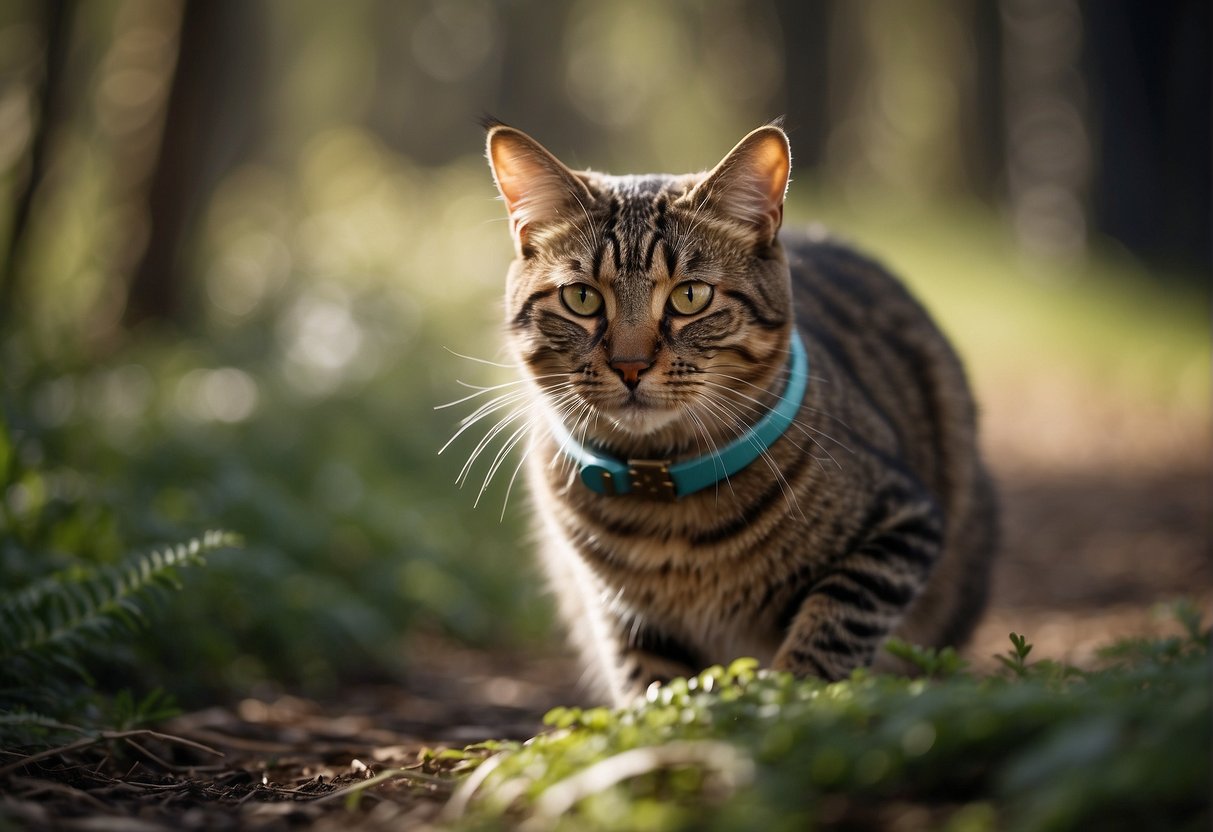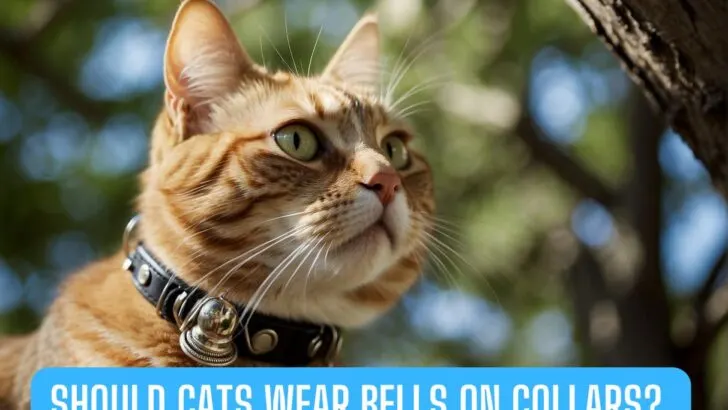Deciding whether your cat should wear a bell on its collar can depend on a mix of safety considerations and the impact on local wildlife. If you’re concerned about your cat’s hunting habits, attaching a bell to their collar can give birds and small mammals a chance to escape, potentially reducing the likelihood of your feline friend harming local ecosystems.
On a safety note, a bell can also serve to alert you to your cat’s whereabouts, which can be particularly useful if they have a habit of hiding or getting into places they shouldn’t.

However, not all cats take well to having a bell around their neck, I know this from first hand experience with my cat Harley. Some might find the constant jingling bothersome, which could lead to stress or even attempts to remove the collar.
A bell might work for one cat, while another prefers the quiet life of a bell-less collar. Moreover, the effectiveness of a bell comes into question with particularly stealthy or fast cats that can still catch prey despite the warning jingle.
Consider starting with a small, lightweight bell to see how your cat adjusts. Some cats may not mind the accessory and you might find comfort in the extra awareness it brings to their presence, especially during those dusk-till-dawn adventures.
Collar Bells Can Have An Impact On Surrounding Animals

When considering whether to put a bell on your cat’s collar, the potential impact on local wildlife is a significant factor. Bells are thought to help mitigate predation, but their effectiveness is subject to debate.
Predation and Conservation
Your cat’s natural instincts to hunt can have a surprising impact on local ecosystems. Cats are known predators of birds and small mammals, which play crucial roles in maintaining healthy ecosystems.
Predation by cats can lead to lower prey populations, particularly affecting bird species. Conservation efforts often suggest measures to reduce such predation rates, especially where wildlife is already vulnerable.
For instance, in regions where native bird populations are in decline, allowing your cat to roam outdoors without a bell may inadvertently worsen the situation.
Studies indicate that domestic cats contribute to a significant percentage of wildlife predation, which has led to a push for responsible pet ownership practices that consider the broader ecosystem.
Effectiveness of Bells
Attaching bells on cat collars has been widely advocated as a measure to reduce hunting success. The idea is that the bell’s noise will alert potential prey, giving them a chance to escape. However, the real question is: How effective are these bells?
- Wildlife Alert: Bells produce sound, typically within the range of 50-60 dB, with the intent of warning wildlife of your cat’s presence.
- Hunting Disruption: A bell may disrupt your cat’s stealthy hunting tactics, potentially giving prey such as birds enough warning to fly away.
However, some studies have raised questions about the actual effectiveness of bells in preventing cats from catching wildlife. The inconsistency in effectiveness could be due to the prey’s reaction time, the environment, or even the cat’s ability to move without ringing the bell.
Some cats might learn to hunt without causing the bell to ring, thereby negating its intended purpose.
How Collar Bells Affect Cat Behavior
Gaining insight into your cat’s natural instincts and responses is crucial for determining whether a bell on their collar is beneficial.
Sensory Stimulation
Cats have highly developed senses that play a significant role in their interaction with the environment. They rely on auditory cues for hunting and communication.
The sound of a bell can provide sensory stimulation, which could be either positive, by engaging their hearing, or negative, if the noise is incessant and bothersome, depending on the individual cat’s tolerance.
Stress and Anxiety Factors
It’s essential to consider stress and anxiety levels in your cat. Some cats may show signs of stress or anxiety when wearing a collar with a bell due to the unfamiliar sound.
Observe your cat’s behavior for any changes, such as hiding more often or attempting to remove their collar, which might indicate that the bell is causing distress.
Assessing Safety and Well-Being
When considering whether to attach bells to your cat’s collar, your cat’s safety and overall well-being are paramount. The right collar features can make all the difference, and it’s crucial to weigh the risks against the benefits of an indoor lifestyle.
Collar Safety Features
It’s important to choose a breakaway collar for your cat, which is designed to unclasp if it gets caught on something. This safety feature greatly reduces the risk of strangulation. Collars with a quick-release buckle can also be beneficial, allowing your cat—or you—to remove it easily in case of emergency.
The Risk of Choking
While collars serve various purposes, there is always a choking hazard to consider. Monitor how your cat interacts with a collar. If they frequently scratch at it or seem distressed, you may need to reconsider its use.
Additionally, watch out for objects in the house that the collar could get hung up on, which might lead to a collar-related injury.
Opportunities for an Indoor Lifestyle
An indoor cat is often at reduced risk for many dangers found outdoors. If you are considering a bell to prevent hunting, promoting an indoor lifestyle can be an effective alternative. Toys and interactive play can simulate the hunting experience for your cat, providing enrichment without the need for bells or even cat bibs that some use to reduce predation.
Alternatives and Precautions
When considering the well-being of both your own feline friend and the surrounding wildlife, it’s important to weigh the various alternatives and precautions beyond just a bell. Let’s explore some protective accessories and how to create a safe environment for your cat.
Protective Accessories and Their Roles
Collar Alternatives:
- Reflective Collars: Highly visible, these collars make your cats more noticeable to drivers at night, reducing the risk of accidents in your neighborhood.
- BirdsBeSafe Collar Covers: Designed to be brightly colored, these can help warn birds and other wildlife before your cat gets too close. It’s a fashionable anti-hunting accessory that respects animal diversity.
Precautions with Collars:
- Ensure Proper Fit: A collar should be snug, yet allow two fingers to fit comfortably between the collar and your cat’s neck.
- Breakaway Mechanism: Collars equipped with this feature can prevent your cat from getting caught on branches or fences, reducing the risk of injury.
Creating Safe Environments
Cat Enclosures:
- Benefits: Enclosures provide a secure outdoor space for your cat to explore while protecting them from large predators and preventing them from hunting.
- DIY vs. Commercial Solutions: You could construct a cat patio (catio) yourself or purchase a pre-made one depending on your comfort with tools and budget.
Indoor Environments:
- Enrichment: Ensure there are plenty of activities inside, such as climbing trees and interactive toys, to keep your cat stimulated and deter the need for outdoor hunting adventures.
- Training: Engage in play with toys that mimic prey, like feathers or laser pointers, to satisfy your cat’s hunting instincts in a safe and controlled manner.

My name is James, and welcome to FAQCats!
Along with our team of cat owners, expert pet enthusiasts, and pet professionals, we aim to write engaging helpful, engaging content about cats. At FAQCats we strive to provide content that’s accurate and fun to read. Our team writes about everything related to cats; even the most complex of topics. Through extensive research and caring for our own fur-pals, we’re able to provide something cat owners worldwide will love. Have a look around, and leave us feedback anytime!

